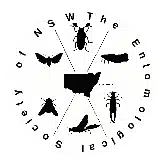Contents Vol. 51 (Public)
These papers are currently only available to members of the Entomological Society of New South Wales, or directly from the author. Once the entire Journal 50 is published they will also be available through Informit. They will be made freely available to all via this website once volume 51 is published in its entirety (approximately one year later). Members should log in from the main menu (found under Membership drop-down menu) to access these papers.
GENERAL AND APPLIED ENTOMOLOGY
The Journal of the Entomological Society of New South Wales Inc.
VOLUME 51
CONTENTS
Some larval host plants for Aphanasium australe (Cerambycidae: Cerambycinae: Aphanasini): Ptoteacae appear to be the sole larval hosts for this tribe
Webb, G. A.
The range of larval host plants for Aphanasium australe (Boisduval) is expanded to include several species of Grevillea in the Sydney region. Adult A. australe were reared from several species of Grevillea, G. buxifolia (Sm.) R.Br., G. oleoides Sieber ex Schult. & Schult., G. sericea (Sm.) R.Br. and G. speciosa (Knight) McGill. An additional record for Hakea sericea Schrad. & J.C.Wendl. is provided. In Hakea, A. australe has been found to infest the stems and roots but in Grevillea, it appears to be confined to infestation of the root system. The only known larval host records for Aphanasium spp. are Hakea and Grevillea (Proteaceae).
General and Applied Entomology 51: 1-4 (published on-line 11.1.2023)
DNA barcode identification of Australian collected mushroom fly Coboldia fuscipes (Meigen, 1830) (Scatopsidae: Diptera)
Nguyen, D.T., Chen, Y. & Herron, G.A.
Mushroom fly Coboldia fuscipes was recently found contaminating Elizabeth Macarthur Agricultural Institute (EMAI) insectary cultures. Species identification secured via DNA barcoding was followed by phylogenetic analysis to determine the phylogenetic relationship of this introduced pest. We found that DNA barcodes of EMAI-collected C. fuscipes were matched to North American accessions of the species, which might imply a Nearctic rather than Palearctic source origin of the pest in Australia.
General and Applied Entomology 51: 5-7 (published on-line 11.1.2023)
BOOK REVIEW. Tasmanian Mayflies: Identification, Ecology, Behaviour and Imitation by Ron Thresher.
Richard Marchant
General and Applied Entomology 51: 9-10 (published on-line 18.12.2023)
Larval host plants of Scolecobrotus spp. (COLEOPTERA: CERAMBYCIDAE) in southern Sydney (New South Wales, Australia)
Garry A. Webb
The range of larval host plants for Scolecobrotus westwoodi Hope is expanded to include multiple species of Eucalyptus, Corymbia and Angophora in the Sydney region. Larval host records for Scolecobrotus variegatus Blackburn are presented for the first time. Adult S. westwoodi and S. variegatus were reared from a range of species in the Eucalyptus group (Myrtaceae) and sometimes from the same plant host. The two species differ in colour pattern and body length but are otherwise similar in biology in terms of host preferences and larval host damage.
General and Applied Entomology 51: 11-17 (published on-line 18.12.2023)
BOOK REVIEW. Australian Longhorn Beetles (Coleoptera Cerambycidae) Volume 3. Subfamily Prioninae of the Australo-Pacific Region. By Adam Slipinski, Rodger de Keyzer and Mengjie Jin
Mike Bouffard
General and Applied Entomology 51: 19 (published on-line 18.12.2023)
Some Australian native plants as larval hosts of the Elephant Weevil, Orthorinus cylindirostris (F.) (Coleoptera: Curculionidae: Molytinae) and some historical museum records.
Garry A. Webb
Orthorhinus cylindrirostris (F.) was recorded from a range of native host plants around Sydney (NSW). All six species have not previously been recorded as larval host plants for O. cylindrirostris. Specimen records from several Australian insect collections were also collected. Orthorhinus cylindrirostris is now known to breed in the wood of 29 plant species representing 21 plant families. Orthorhinus cylindrirostris is polyphagous and so far there appears to be only one direct familial link between native and introduced plant species (Sapindaceae). Most historical records indicate that O. cylindrirostris was well known as a pest of agriculture (specifically citrus and grapevines) in the late 1800’s but there were no specific records of their native host plants until very recently.
General and Applied Entomology 51: 21-25 (published on-line 25.2.2024)
Aphid trapping records in northern Sydney for spring, summer and autumn, 2020-21
Dinah Hales
General and Applied Entomology 51: 27-36 (published on-line 22.2.2024)
This paper reports on aphids caught in a yellow trap in the Sydney suburb of Beecroft for spring 2020 through to the end of autumn 2021. It is a continuation of observations previously reported for autumn-winter 2020 and compares data from the full year winter 2020 to autumn 2021 with data from collections made in the nearby suburb of Rydalmere in 1960-1. Season for season, over 65% of the aphid species found in 1960-1 were not found in 2020-1, but 30-50% of the catch was made up “new” species, mostly not recorded in Australia at the time of the earlier project. Biological characteristics of the missing species such as host range and annual cycle were examined, but no consistent trend was identified to account for their absence. It may result partly from stabilisation of low population sizes after initial explosions following introduction. Weather during the two collections was also examined. Whilst 2020-1 was generally warmer and had more hot days, the differences seemed unlikely to have caused the substantial loss of species. Events of heavy rainfall in 1961 and in 2021 were followed by loss of species. Extremes of weather occurred during 2019 and early 2020, with low rainfall, high temperatures, strong winds and extensive bushfires. These would inevitably have affected aphid populations. Other environment are noted.
BOOK REVIEW. Applied Environmental Genomics. Eds. Oliver F. Berry, Clare E. Holleley and Simon N. Jarman. Hardback, December 2023, $200 ISBN: 9781486314928, 368 pages. Publisher: CSIRO Publishing. Colour plates, Illustrations, Photographs
Duong Nguyen |
General and Applied Entomology 51: 38-39 (published on-line 22.2.2024)
